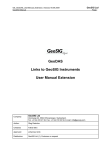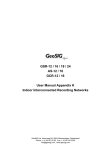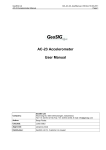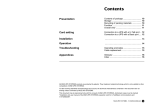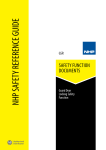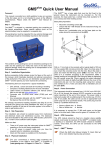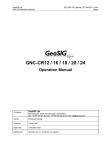Download User Manual Appendix - Alarm
Transcript
GSR-12 / 16 / 18 AS-12 / 16 GCR-12 / 16 User Manual Appendix I Alarm Interface GeoSIG Ltd, Ahornweg 5A, 5504 Othmarsingen, Switzerland Phone: + 41 44 810 2150, Fax: + 41 44 810 2350 [email protected], www.geosig.com GS_GSR_GCR_UserManual_App_I_Alarm_V02.doc / 18.09.2009 GXR Manual Appendix I Alarm Interface ii Document Revision Author Checked Approved Alexandre Beaud Ricardo Araujo Talhan Biro Version 15.09.2006 21.04.2008 29.10.2008 14.05.2009 Action First Issue (AB) New configuration possibilities with GS_ICRC board (AB) Update of headings (TB) Change front page to Appendix I Disclaimer GeoSIG Ltd reserves the right to change the information contained in this document without notice. While the information contained herein is assumed to be accurate, GeoSIG Ltd assumes no responsibility for any errors or omissions. Copyright Notice No part of this document may be reproduced without the prior written consent of GeoSIG Ltd. The software described in this document is furnished under a license and may only be used or copied in accordance with the terms of such a license. Trademark All brand and product names mentioned are trademarks or registered trademarks of their respective holders. All rights reserved. GeoSIG Ltd Switzerland GS_GSR_GCR_UserManual_App_I_Alarm_V02.doc / 18.09.2009 GXR Manual Appendix I Alarm Interface iii Table of Contents Symbols and Abbreviations ................................................................................................. 4 1. Introduction...................................................................................................................... 5 2. Output Configuration ....................................................................................................... 6 2.1. Diagram of the Alarms Relays with Connected Common Contacts .......................................................7 2.2. Diagram of the Alarms Relays with Separated Relay Contacts..............................................................8 3. Connector Pin Out Configuration..................................................................................... 9 3.1. Unique Relays Common Point ................................................................................................................9 3.2. Separate relays common point ...............................................................................................................9 4. Electrical Specifications ................................................................................................... 9 5. Software Alarm Configuration........................................................................................ 10 6. GXR-ALC Options ......................................................................................................... 11 6.1. GXR-ALC-JB Junction Box ...................................................................................................................11 6.2. GXR-L-AL Alarm Light ..........................................................................................................................12 GS_GSR_GCR_UserManual_App_I_Alarm_V02.doc / 18.09.2009 GXR Manual Appendix I Alarm Interface iv Symbols and Abbreviations GXR-ALC GXR-ALC-JB GXR-L-AL GeoDAS Instrument GXR Recorders Alarm Interface Card Alarm Interface Card Junction Box Warning Light Module for Alarm Interface Card GeoSIG Data and Analysis Software GeoSIG recorders GS_GSR_GCR_UserManual_App_I_Alarm_V02.doc / 18.09.2009 GXR Manual Appendix I Alarm Interface 5 1. Introduction a Dear Valued GeoSIG Customer, thank you for purchasing this product. These Instruments have been optimised to meet the requirements of the majority of customers out of the box and may have even be delivered tailored to your needs. In any case, to be able to get the most out of our product, please carefully study this manual, its appendices and referenced manuals, as well as any other documents delivered with it. This is a reliable and easy to use device, and at the same time a sophisticated product, which requires care, attention and know-how in configuring, installing, operating and maintenance. The GXR-ALC is the alarm interface card for GeoSIG recorders. The GXR-ALC is compatible with any GXR Recorder and adds an hardware interface for user defined levels threshold, event detection and equipment fault. It is designed to have a very flexible connectivity, making it compatible with many external interfaces. A user friendly interface for configuring the threshold levels and other options is provided through GeoDAS (refer to GeoDAS manual for details). The GXR-ALC is equipped with three independent relays. Two of it are used for user level defined threshold alarms and the third one is used for event trigger detection and/or equipment fault. GS_GSR_GCR_UserManual_App_I_Alarm_V02.doc / 18.09.2009 GXR Manual Appendix I Alarm Interface 6 2. Output Configuration The GXR-ALC has many connectivity options, providing to the user many possibilities for interfacing any external device. There are three main options that can be chosen. The first option is if the relays should be normally powered or normally not powered. This has an influence on the reaction of the interface. A normally powered relay will invert the polarity of the contacts at power up and power down, this may be very useful to detect if the instrument is still running. If the GXR-ALC is configured to have normally powered relays, then the polarity of the contacts will be inverted in case of shutdown of the instrument. Please note that if the relays are normally powered during operation, consumption of the instrument will be higher. a Each relay can be configured separately for normally powered or normally not powered operation. The second option is the contacts default position. The contacts can be normally closed (NC) or normally open (NO) depending on the user choice. This option depends mainly on the interface that will be connected to the instrument. a Each relay can be configured separately for normally open or normally closed operation. The third option is the pin out of the alarm interface connector. The common point of the relays contacts can be separate for each relay or it can be a single pin for all relays. a All relays must be configured to have a common contact pin for all, or three separate common contact pins. A mix between this configuration is not possible. Contacts output configuration. Normally powered or normally not powered jumpers. Figure 1. Alarm Board Jumpers a Note that alarm 3 cannot be used in an instrument equipped with a GPS! GS_GSR_GCR_UserManual_App_I_Alarm_V02.doc / 18.09.2009 GXR Manual Appendix I Alarm Interface 7 2.1. Diagram of the Alarms Relays with Connected Common Contacts The following table shows the possible configuration for an GXR-ALC with the common contact of the relays connected together to one pin of the connector. Note that the contacts shown are during normal operation of the system. Please specify the required configuration (A, B.. or H) when ordering a GXR-ALC option. If no special configuration is requested, then option A will be supplied. Ref. Jumper Configuration A JMP1, 2, 3: 1-2 JMP1_1: 1-2 JMP1_2: 3-4 JMP2_1: 1-2 JMP2_2: 3-4 JMP3_1: 1-2 JMP3_2: 3-4 Relays Contacts AL1 AL2 AL3 Remarks Relays normally not powered Normally open contacts Standard supply to customer, if no configuration requested. COM B JMP1, 2, 3: 2-3 JMP1_1: 1-2 JMP1_2: 3-4 JMP2_1: 1-2 JMP2_2: 3-4 JMP3_1: 1-2 JMP3_2: 3-4 AL1 AL2 Relays normally powered Pin 7 of J_OUT connected to GND. AL3 COM C JMP1, 2, 3: 1-2 JMP1_1: 3-4 JMP1_2: 3-4 JMP2_1: 5-6 JMP2_2: 3-4 JMP3_1: 5-6 JMP3_2: 3-4 AL2 Relays normally not powered Pin 7 of J_OUT connected to GND. AL3 Normally closed contacts. AL1 COM D JMP1, 2, 3: 2-3 JMP1_1: 3-4 JMP1_2: 3-4 JMP2_1: 5-6 JMP2_2: 3-4 JMP3_1: 5-6 JMP3_2: 3-4 AL2 Relays normally powered Pin 7 of J_OUT connected to GND. AL3 Normally open contacts. AL1 COM Table 1. Diagram of the alarms with unique common point for all alarms GS_GSR_GCR_UserManual_App_I_Alarm_V02.doc / 18.09.2009 GXR Manual Appendix I Alarm Interface 8 2.2. Diagram of the Alarms Relays with Separated Relay Contacts The following table shows the possible configuration for an GXR-ALC with separate relay contacts. Note that the contacts shown are during normal operation of the system. Ref. Jumper Configuration E JMP1, 2, 3: 1-2 JMP1_1: 1-2 JMP1_2: 1-2 JMP2_1: 3-4 JMP2_2: 1-2 JMP3_1: 3-4 JMP3_2: 1-2 Relays Contacts AL1.1 Remarks Relays normally not powered Normally open contacts. AL1.2 AL2.1 AL2.2 AL3.1 AL3.2 F JMP1, 2, 3: 2-3 JMP1_1: 1-2 JMP1_2: 1-2 JMP2_1: 3-4 JMP2_2: 1-2 JMP3_1: 3-4 JMP3_2: 1-2 AL1.1 Relays normally powered Normally closed contacts. AL1.2 AL2.1 AL2.2 AL3.1 AL3.2 G JMP1, 2, 3: 1-2 JMP1_1: 3-4 JMP1_2: 1-2 JMP2_1: 7-8 JMP2_2: 1-2 JMP3_1: 7-8 JMP3_2: 1-2 AL1.1 Relays normally not powered Normally closed contacts. AL1.2 AL2.1 AL2.2 AL3.1 AL3.2 H JMP1, 2, 3: 2-3 JMP1_1: 3-4 JMP1_2: 1-2 JMP2_1: 7-8 JMP2_2: 1-2 JMP3_1: 7-8 JMP3_2: 1-2 AL1.1 AL1.2 AL2.1 AL2.2 AL3.1 AL3.2 Table 2. Diagram of the alarms with separate common point for alarms Relays normally powered Normally open contacts. GS_GSR_GCR_UserManual_App_I_Alarm_V02.doc / 18.09.2009 GXR Manual Appendix I Alarm Interface 9 3. Connector Pin Out Configuration The user interface for connecting the relays to an external device is a 7 pin female connector assembled to the instrument. For the connection the user receives a 7 pin male connector. 3.1. Unique Relays Common Point If the alarm card is configured for having a unique common point for all the relays (configurations A to D), then the pin out is as shown in the above table. Pin Alarm Description 1 AL1 Alarm 1 (user defined level) 2 AL2 Alarm 2 (user defined level) 3 AL3 Alarm 3 (trigger or equipment fault) 4 N.C. Not connected 5 N.C. Not connected 6 N.C. Not connected 7 COM Common point of all alarms Table 3. Connector pin out with unique common point for all alarms 3.2. Separate relays common point If the alarm card is configured for having separate common points for each relays (configurations E to H), then the pin out is as shown in the above table. Pin Alarm Description 1 AL1.1 Alarm 1 (user defined level) 2 AL1.2 Alarm 1 (user defined level) 3 AL2.1 Alarm 2 (user defined level) 4 AL2.2 Alarm 2 (user defined level) 5 AL3.1 Alarm 3 (trigger or equipment fault) 6 AL3.2 Alarm 3 (trigger or equipment fault) 7 N.C. Not connected Table 4. Connector pin out with separate common point for alarms a Note that alarm 3 cannot be used in an instrument equipped with a GPS! 4. Electrical Specifications The contacts are suitable for a low voltage control: • Max voltage: 125VAC / 125 VDC • Max current: 250 mA In case large load must be switched then external relays should be implemented. 10 GS_GSR_GCR_UserManual_App_I_Alarm_V02.doc / 18.09.2009 GXR Manual Appendix I Alarm Interface 5. Software Alarm Configuration The alarm configuration is done through GeoDAS software. In order to be able to make the configuration, the instrument must be connected to the computer running GeoDAS (for details check the GeoDAS and instrument manuals). Alarm 1 and alarm 2 levels are set in the bottom part of the window. The levels can be set from 0.1 % of full scale value to full scale value for each axis. Alarm 1 corresponds the “Low Alarm” and alarm 2 corresponds to the “High Alarm”. Also the active time of the alarms can be set in GeoDAS software, it can be set from 1 to 60 seconds. The alarm 3 can be configured to be active on event trigger, on error detection or on error, warning and no AC. A test utility for testing alarm 1 and alarm 2 are also available from the software interface. Figure 2. GeoDAS Alarm Configuration Window GS_GSR_GCR_UserManual_App_I_Alarm_V02.doc / 18.09.2009 GXR Manual Appendix I Alarm Interface 11 6. GXR-ALC Options The following options are options that can be ordered with the GXR-ALC option. 6.1. GXR-ALC-JB Junction Box The GXR-ALC-JB is a junction box, providing to the user terminals for the connections of the alarm contacts. Figure 3. Junction Box Figure 4. Terminals The pin out of the terminals of the junction box is shown in the above table: Terminal A1 O1 A2 O2 A3 O3 Description Alarm 1 (user level defined) Alarm 1 common point Alarm 2 (user level defined) Alarm 2 common point Alarm 3 (equipment fault) Alarm 3 common point Table 5. Junction Box Connections a Note that alarm 3 cannot be used in an instrument equipped with a GPS! GS_GSR_GCR_UserManual_App_I_Alarm_V02.doc / 18.09.2009 GXR Manual Appendix I Alarm Interface 12 6.2. GXR-L-AL Alarm Light The GXR-L-AL is an alarm warning light that can be connected to the alarm interface. The alarm is normally configured to be connected to alarm 3 (equipment fault or event detection). Once the alarm light is turned on, a button must be pressed in order to disable the light. The GXR-L-AL must be powered from an external 230 VAC supply. Figure 5. GXR-L-AL Alarm Light a Note that alarm 3 cannot be used in an instrument equipped with a GPS!












